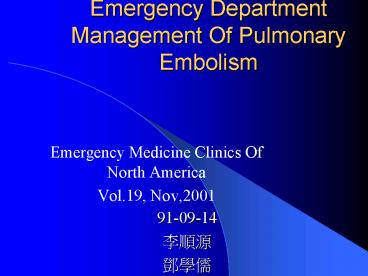Emergency Department Management Of Pulmonary Embolism - PowerPoint PPT Presentation
1 / 23
Title:
Emergency Department Management Of Pulmonary Embolism
Description:
Emergency Department Management Of Pulmonary Embolism. Emergency Medicine Clinics ... 1960s, anticoagulant therapy mainstay for PE ... – PowerPoint PPT presentation
Number of Views:192
Avg rating:3.0/5.0
Title: Emergency Department Management Of Pulmonary Embolism
1
Emergency Department Management Of Pulmonary
Embolism
- Emergency Medicine Clinics Of North America
- Vol.19, Nov,2001
91-09-14 ??? ???
2
Frameworks
- 1. Introductions
- 2. Natural history of pulmonary embolism
- 3. Risk stratification
- 4. Goals of therapy
- 5. Unfractionated heparin (UFH)
- 6. LMWH
- 7. Thrombolytic therapy
- 8. IVC filter
- 9. Transvenous catheter embolectomy
- 10.Surgical embolectomy
3
Introduction (1)
- Greatest threat to patient with PE is failure to
be diagnosed. - Correct decision regarding therapy can be made
only after a correct diagnosis
4
Introduction (2)
- The physician must know
- 1. Natural course of events without
treatment - 2. How are these events improved by therapy
- 3. To which extent are these improvements
mitigatated by adverse effects of this therapy
5
Introduction (3)
- 1960s, anticoagulant therapy ? mainstay for PE
- 1970s, thrombolytic therapy began to use in PE (
esp. presenting in shock) - 1990s, focused on risk stratification, extension
of indication for thrombolytic therapy, use of
LMWH, newer mechanical methods of therapy, and
surgical embolectomy.
6
Introduction (4)
- The differential diagnosis is important since the
treatment for PE is contraindicated in some of
these conditions, such as pericarditis and aortic
dissection.
7
Natural history of pulmonary embolism
- Clots fron veins in legs, pelvis, and arm
?embolize to the lung?pulmonary vascular
obstruction release vasoactive agents? increase
pulmonary resistance?right ventricular
dysfunction(hypertension, ischemia, and
hypokinesis)? inadequate C.O. and death
8
Natural history of pulmonary embolism (2)
- Approximately 10 patients die within the first
hour of PE ( diagnosis and therapy unfeasible) - Survive within first hours and remain untreated,
approximately 30 will die of PE, usually from
recurrent embolism and right heart failure. - changes in position of the clots or endogenous
fibrinolysis ? favorable outcome?less mortality
9
Risk Stratification
- Treatment must be tailored to the individual
patient, a one-size-fits-all policy does not
make pathophysiologic sense. - Prognostic factors
- 1. Embolic load
- 2. Underlying cardiopulmonary reserve
- 3. Status of the right ventricle
10
Risk Stratification (2)
- In a multicenter study (2500 Pt of PE)
- RV dysfunction is an independent predictor of
mortality.
11
Goals of therapy
- 1. Immediate goals of therapy
- ?normalize pulm. vascular resistance
- ? reduce recurrent embolism
- 2. long term goals
- ? reduce the frequency of chronic
pulmonary hypertension
12
Unfractionated Heparin (NFH)
- For decades, unfractionated heparin ? cornerstone
of therapy for PE - Unless contraindicated, heparin is used in
high-likelihood patients - Heparin? accelerating the action of
- AT-III? prevent further clot formation
13
Unfractionated Heparin (2)
- Several points bear emphasis
- 1. UFH, IV customarily, can be SC
- 2. Adequate initial anticoagulation is
important to reduce the likelihood of recurrent
venous thromboembolism
14
Unfractionated Heparin(3)
- Recommended dose of heparin
- Initial 80 IU/kg, iv, bolus
- Maintain 18 IU/kg/hr, infusion
- ( P/s once fully heparinization, a first dose of
warfarin can be administered )
15
Low molecular weight heparin
- Multiple studies have shown that LMWH are equal
in efficacy to UFH in the treatment of venous
thromboembolic disease - Enoxaparin and tinzaparin FDA approved on Nov,
2000
16
Low molecular weight heparin(2)
- Venous thromboembolic disease? primary
manifestation is DVT, with or without PE, can be
treated as out-patient ( carefully selected
patient hemodynamic stable and normal RV
function) - If primary manifestation is PE? out-patient
therapy is not recommended - Admitted Pt with PE ( LMWH is used)
- 1.shorten the length of stay
- 2.not costly than using UFH
17
Thrombolytic Therapy
- Advantages of thrombolytic therapy
- 1. Rapid clots lysis ? reduce pulm.
- hypertension
- 2. Reduce recurrent rate ? reduce
- mortality rate
18
Thrombolytic Therapy (2)
- Risk stratification and individualization of
therapy are important
19
Thrombolytic Therapy (3)
- Bleeding risk 13
- Bleeding complication
- major bleeding ( 510 )
- ICH ( 12 )
20
Inferior Vena Cava Interruption
- Placement of IVC filter increasing? long term
outcome (?) - Indications
- 1. Contraindication to anticoagulant
- 2. Failure of anticoagulation
21
Transvenous Catheter Embolectomy
- In whom thrombolysis fails or is contraindicated
- Very ill and require a rapid approach
22
Surgical Embolectomy
- Indications
- 1.massive PE with shock and too ill for
- thrombolytic therapy
- 2. Contraindication to or failure of
- thrombolytic therapy
- Mortality still high 2040
- Worse in those pre-op cardiac arrest
23
Summary
- 1. Chest pain, dyspnea, syncope, oxygen
desaturation, or unexplained hypotension
?consider the diagnosis of PE evaluate
rationally - Develop algorithms ?both diagnostics
therapeutics flow smoothly and rapidly - Concept of risk stratification and
individualization of therapy is important.































